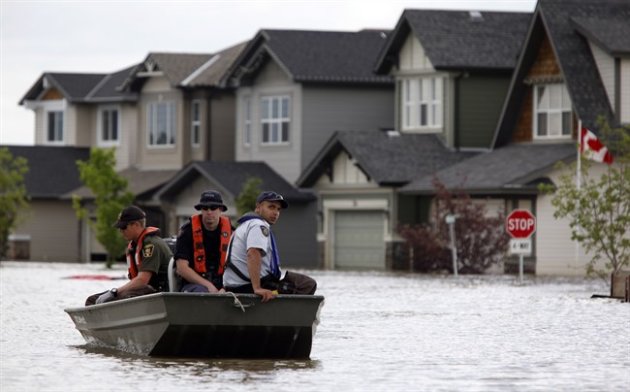Caveat Emptor
In any civilized, responsible society licensing to proceed with the building of a home must be applied for through an application process to local municipal authorities. The township or city will have put together a series of criteria in respect of its own or its province's building codes or a combination of same. Anyone planning to renovate, construct, excavate a building must first make application and hope thereby to obtain the necessary building permit allowing them to proceed.
Flooded homes in High River's Hampton Hills neighbourhood on June 29, 2013. (Emily Senger/Maclean's)
There is legislation to be met, including conservation authority approvals, and requirements under the Environmental Protection Act. As such, it would seem to be common sense that building permits would be issued to legally construct only in those areas that are not environmentally vulnerable. Which should automatically by definition alone, rule out issuing building permits in flood-prone areas susceptible to, of course, flooding.
"We know that floodway development is dangerous. Development in these areas puts lives at risk and is an ongoing risk to taxpayers as well. I've equated it many times to building on the train tracks. This new policy will allow Albertans in the impacted floodways another option to rebuild their lives and will provide protection for all Albertans going forward", announced the province's Municipal Affairs Minister Doug Griffiths in the recent revelations of provincial assistance to flood victims.
Six communities in southern Alberta were devastated by massive flooding in June. Hundreds of homes were under water for prolonged periods of time, their owners and families evacuated to safety, anxious to return to their homes with the floodwaters having retreated and huge clean-up efforts underway. Those homes built on flood plains -- known flood plains -- are eligible for a single-occasion provincial buyout valued at the tax-assessed worth of the home.
 |
| Calgary.ctvnews |
Those homes that are set to be purchased by the province on acceptance by their owners of the exchange, will be destroyed or sold and moved from the flood area. In all probability, most of those hundreds of homes whose settlement costs have been assessed collectively to run around $175-million for the province, will have to be destroyed. They will be judged to be uninhabitable, threaded through with dangerous moulds, their integrity destroyed.
"The way that this program is set up it is my anticipation that there will be very, very few people who will not take the 100% assessment -- take their value and move to another location. We want to make sure we take the property ... the home ... out of the floodway. Whether or not that means the home gets torn down or picked up and relocated ... we'll work on that on a case-by-case basis", the minister elaborated.
Hard-hit neighbourhoods in High River that were flooded out, but whose homes were not built on a flood plain will not be offered this provincial assistance. Water filled the area and settled to create an extensive flood-lake in the Hamptons neighbourhood -- not a flood plain. Owners there, viewing the absolute certainty that their homes will have to be destroyed due to irreparable damage, would also like a similar financial benefit.
 |
| ca.news.yahoo.com |
It is precisely because homes were deliberately built, with permission on such sensitive areas that there should be no taxpayer-funded recompense. Is insurance not available for homes built on flood plains? Should that tell us something? The mere fact that the municipality gave assent to builders to construct homes on flood plains left prospective buyers with a sense of ease over the matter. To which, no doubt, the government is now responding.
Yet those home owners who chose to build in areas where danger of flooding was unlikely to occur, doing the responsible thing on their own initiative, are left to carry their own sad, sorry dripping bag.
To which the Municipal Affairs Minister responded: "This is a policy to deal with the floodway. It's the fastest-moving water that's the most dangerous. The Hamptons are neither in the floodway or the flood fringe. I know they suffered damage. We have the [recovery] program which will help them rebuild their homes -- tear them down and rebuild them -- because that is a viable neighbourhood and a viable community. I know that some of them are frustrated and they don't want to be there, but they have the option of rebuilding their homes and moving if they like."
Some option.
Some responsible, caring response. The one-time offer to buy to the flood-plain built home owners is contingent on their not deciding to rebuild their homes in the very same flood-plains over again. How is that responsible, rather than enacting long-overdue legislation to forbid building on such areas to begin with?
Labels: Alberta, Canada, Environment, Natural Disasters, Nature

0 Comments:
Post a Comment
<< Home